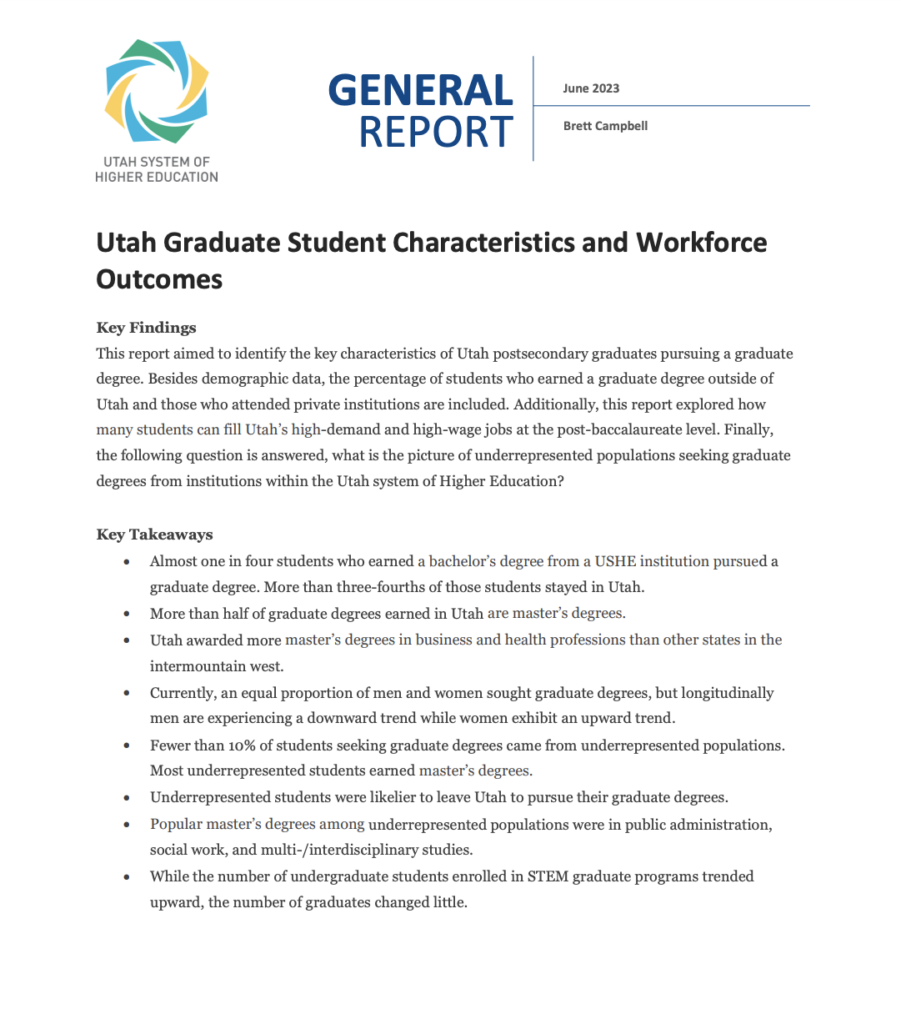USHE researchers released an analysis of graduate students enrolled at Utah’s public institutions of higher education. This research, authored by Brett Campbell, aimed to track Utah’s bachelor’s degree earners into and through graduate school. Graduates included in this study received their bachelor’s degrees between 2014 and 2019. These students were matched to enrollment in a Utah System of Higher Education (USHE) graduate program between 2015 and 2022. The data in this project came from USHE internal enrollment records and from the National Student Clearinghouse (NSC).
Finding 1: The percentage of students seeking graduate degrees in Utah is similar to the national level.
25.6% of all degrees conferred in Utah are from graduate-level programs.
- More than three-fourths of Utah’s bachelor’s degree recipients who go on to graduate school stayed in Utah for their graduate studies.
- Of Utah’s graduate students, 54.0% earned a master’s degree; 1.3% earned a doctoral research degree (Ph.D.); and 8.6% earned professional degrees (M.D., J.D., etc.). The remaining 36.1% had not earned a graduate degree by spring 2022.
- The proportion of graduate students who are men is decreasing, while the proportion of graduate students who are women is increasing.
Figure 1.1: Composition of graduate students over time by gender
Figure 1.2: Distribution of graduate degrees earned by gender and Utah residence
Figure 1.3: Graduate degree lengths (in months) by institution type and location
Finding 2: Utah’s graduate students are concentrated in fewer fields of study compared to graduate students across the nation. Utah students’ interests also differ from those of neighboring states.
Utah graduate students enroll in business and health profession programs in higher numbers than students in other states.
Far fewer Utahns enroll in computer sciences, social sciences, psychology, and the natural sciences.
- Business, management, and marketing; health professions; and education make up 54.0% of all master’s degrees awarded in Utah.
- Engineering; biological and biomedical sciences; and physical sciences comprise 46.0% of all doctoral research degrees awarded in Utah.
- All doctoral professional degrees awarded in Utah are in the health professions (76.0%) or law (24.0%).
Figure 2.1: Master’s degree areas of study by state
Figure 2.2: Graduate degrees conferred in Utah’s five most popular areas of study by award type
Finding 3: Utah STEM graduate students show higher enrollment in computer and information sciences, the health professions, natural resources, and multi- and interdisciplinary studies. National averages have higher enrollment in engineering, biology and biomedical sciences, social sciences, and agricultural sciences.
- While the number of undergraduate students enrolled in STEM programs trended upward, the number of graduate students enrolled in STEM changed little.
- Engineering is the most popular STEM doctorate degree. Far more doctorates are earned in engineering than other STEM fields.
- Among those who earn master’s degrees in STEM fields, women were overrepresented in psychology, the health professions, and multi/interdisciplinary studies. In contrast, men were overrepresented in engineering and computer and information systems.
Figure 3.1: National and statewide shares of STEM enrollees in specific areas of study
Figure 3.2: STEM graduate degrees conferred in Utah’s five most popular areas of study by award type
Finding 4: Underrepresented populations make up less than 10.0% of graduate students.
- Underrepresented students are herein defined as those identifying as Black/African American, Native American/Alaskan Native, Native Hawaiian/Pacific Islander, Latinx/Hispanic, or of two or more racial identities. Those of Asian descent and White students are omitted.
- Most underrepresented students who completed graduate programs earned master’s degrees.
- Underrepresented students were more likely to leave Utah to pursue their graduate degrees than non-underrepresented students.
- Popular master’s degrees among underrepresented populations were in public administration, social work, and multi- and interdisciplinary studies.
- Underrepresented students comprise 9.6% of all professional doctorate graduates in the health sciences and 12.2% of all graduates in law.
Figure 4.1.Distribution of graduate degrees earned by underrepresented status
Figure 4.2. Distribution of graduate degrees earned by underrepresented status and student origin
Limitations
- These analyses are descriptive and do not identify causal relationships.
- Much of this research is from secondary sources. Errors in collection or imputation are unknown.
Conclusion
- One in four students who earn a bachelor’s degree in Utah pursue a graduate degree.
- Utah’s graduate students are more heavily concentrated in business, management, and marketing or the health professions than graduate students from neighboring western states.
- Among those who earned master’s degrees in STEM, the engineering and computer and information sciences fields are the most popular.
- Underrepresented students are more concentrated in master’s programs (as opposed to doctoral research or professional practice programs) than non-underrepresented students.
This report aimed to identify the key characteristics of Utah’s postsecondary graduates pursuing a graduate degree. Besides demographic data, the percentage of students who earned a graduate degree outside of Utah and those who attended private institutions are included. Additionally, this report explored how many students can fill Utah’s high-demand and high-wage jobs at the post-baccalaureate level. Finally, the report examines underrepresented students as they pursue graduate degrees.

Glossary
- CIP Family: The first two digits of the Classification of Instructional Program taxonomy developed by NCES.
- In-state institution: Any institution providing graduate-level awards within Utah, including non-USHE institutions.
- Ownership: NCES designation as to the ownership of the institution. The local government oversees public institutions, while private institutions include non-profit and for-profit entities.
- Underrepresented students: Students who identify as Black/African American, Native American/Alaskan Native, Native Hawaiian/Pacific Islander, Latinx/Hispanic, or of two or more racial identities. Those of Asian descent and White students are omitted.


